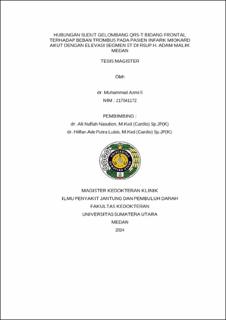| dc.description.abstract | Introduction: According to the World Health Organization (WHO), heart disease is the highest cause of death in the world, about 17.9 million people in 2016 died from cardiovascular disease, or about 32% of total deaths. In Indonesia, based on the results of the Basic Health Research (RISKESDAS) in 2018, 15 out of 1000 people in Indonesia have coronary heart disease. Several electrocardiogram parameters have been used to determine high-risk patients during IMA-EST, one of which is the frontal plane QRST angle (fQRST). The frontal QRS-T angle is a new risk marker as the absolute value of the difference between the frontal QRS axis and the T axis on a 12-lead ECG reflecting objective ventricular myocardial repolarization.
Method: this study is a prospective study, where sampling was carried out by Consecutive sampling, using secondary data of STEMI patient medical records January 2024 – July 2024, the frontal QRS- T Axis was extracted from the difference in absolute values of axis QRS and axis T, while the thrombus burden was classified using the TIMI Grade score, where TIMI 1-3 was categorized as low thrombus burden and TIMI 4-5 was categorized as high thrombus burden.
Results: The subjects of this study were dominated by male patients, totaling 94 people (87%). The mean age of the subjects was 56.68 ± 10.27. There is a statistically significant relationship between risk factors for high thrombus burden in population with diabetes mellitus ( p=0.002), there is a significant relationship between the angle of the frontal QRS-T wave based on the onset of STEMI
<12H and >12H (p= 0.023) and significance corelation between vessels that have flow blockade (p= 0.032, r= 0.206), There is a significant correlation between the angle of the frontal plane QRS- T wave and thrombus burden (p<0.001). The QRS-t angle of the Frontal plane can be used as a good predictor based on AUC 0.88 (p= 0.0001) with cut-off >61 degrees with sensitivity of 88.3% and specificity of 87.5%.
Conclusion: There is a significant correlation between frontal plane QRS-T wave angle and thrombus burden. | en_US |


